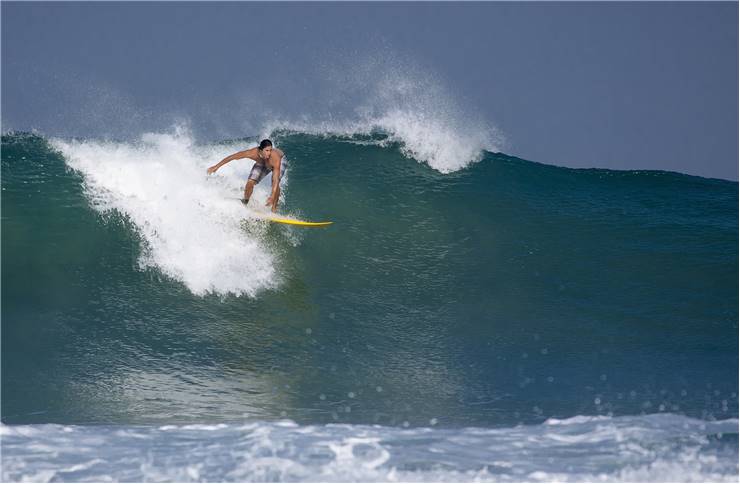History of Surfing - Origins and Evolution of Surfing
In Hawaiian, enalu means the art of surfing. The first man who discovered it was Joseph Banks while staying on the HMS Endeavour. This exploration was the first conducted by Captain James Cook, and the discovery of surfing occurred in the waters of Tahiti. Surfing played a central part in the old Polynesian culture and started to exist long before the Europeans reached that territory.
Other European visitors also contributed to gathering information about surfing by taking photographs of Samoans surfing. Some non-written stories confirm that this water activity was practiced in some canoe hulls in Tonga. King Taufa'ahau Tupou IV was the most prominent Tongan surfer at that time. This surfing style predated the one practiced by Hawaiians and Polynesians for over 1000 years.
In Pre-Incan civilizations, “ Riding a vessel with a wave” was also practiced two thousand years ago and was conveyed in the Chimu culture. The people who used those vessels were called Mochica. Despite using them for fishing, it is reasonable to assume that Mochica used them for fun. Chicama - one of the longest rideable waves in the world, was within the territory of these people. Its location is Puerto Malabrigo, La Libertad, near Trujilio in Peru. Even today, these vessels are used by local fishermen and are usually rented to tourists who seek some recreational fun.
In Hawaiian culture, surfing was not viewed as a hobby, extreme sport, or carrier as it is considered today. Instead, this activity was deeply integrated into Hawaiian culture and looked upon primarily as a form of art. The people of Hawaii prayed to their gods for strength to tackle the ocean, given its power and mystification. Hawaiian priests used to be called upon and asked for assistance in praying for a good wave. This advantage of royalty over commoners was a part of the Kapu system of laws. Those chief riders had priests aiding them in constructing their surfboards. Furthermore, upper-class people gained respect by mastering their riding skills, strength, and agility on waves and maintaining command over their people. Even today, these holy sites for surfers are still prevalent in Kahalu’u Bay and Holualoa Bay.
The materials used for constructing surfing boards used to be determined by the laws of the Kapu system. The essential standard was the type of wood used in making boards due to the rider’s future status in society. In old Hawaiian tradition, people were distinguished as of the class they belonged to. The boards constructed for the royal class had to be between 14 and 16 feet long, and the wood quality had to be top. These long and large boards were also quite heavy (weighing up to 175 pounds). On the other hand, the boards for commoners were about 10 to 12 feet long, but the wood used to make them was significantly heavier and denser (called “koa”). The ceremonial fish was used during prayers before the selection and cutting down of a tree meant to be used for a board. The fish would be put in a hole close to the roots of a tree. Only after the ritual had been done could a craftsman proceed with the board’s construction.
After the settlers came to Hawaii, they needed more respect for this ancient tradition of the invaded land. Their ignorance almost led to an oblivion of surfing culture, while the arrival of western religion was stripping its religious elements. The natives were practically forced to adjust to a new lifestyle, and they were losing touch with their roots.
At the beginning of the 19th century, surfing was almost completely a thing of the past. Only after the following century started to approach was surfing given a whole new level of potential waiting to be revived. Around the 1920s, the design of surfboards and the technology used to create them were far superior compared to the past. Hence, the sport became more accessible to the general public. Moreover, the invention of cards made surfing board transport easier, so surfers could venture along coasts seeking the best surfing conditions.
Duke Kahanamoku was the Hawaiian swimmer who won the first medal at the beginning of the 20th century. His achievement led him to travel throughout the Pacific coast of the USA to demonstrate surfing wowed the masses and became a headline-maker in the news.
Over the following decades, surfing's popularity grew, but the biggest problem was gathering enough sources to build the necessary equipment. Two men were to praise for paving the path of sport’s success. The first one was Bob Simmons, a Californian surfer who managed to find a way to combine fiberglass and styrofoam and apply it to the construction process. That led to a significant reduction in surfboard weight, a big difference from the original surfing boards. The second important contributor was Tom Blake, whose application of a fin onto surfboards in the 1930s enhanced control and maneuverability.
Duke and his friends later became famous in Hawaii as the “ Beach Boys of Waikiki.” The credit was the rebirth of surfing in Hawaii. About two decades before, another person played an important role in reviving surfing. His name was George Freeth. Once, he was asked to demonstrate surfing on California’s popular Redondo beach at the request of the Californian land developer Henry Huntington. Freeth was the first surfer who came up with the idea of cutting the 16-foot design in half. The decision influenced surfers' fans, who started experimenting with their boards, and the new spirit of freedom began to expand among surfers.
One of the most important innovations in surfing history is the wetsuit. The first one was made in the early 1950s in California. The introduction of wetsuits enabled surfing all year round and made it possible to surf for longer times in colder waters.


